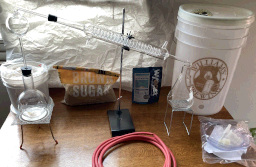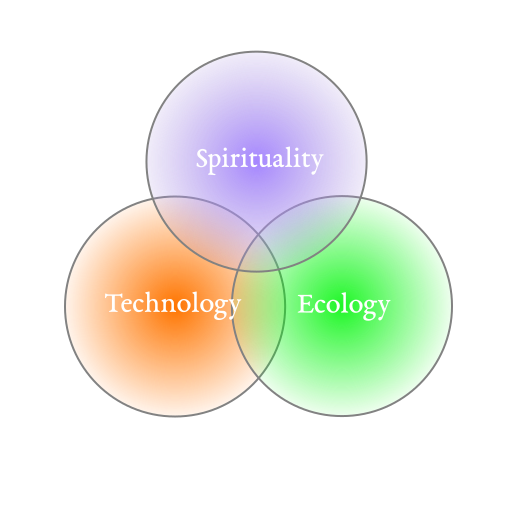Ecological Ethanol
I first heard about the idea of growing one's own fuel from Farmer Dave Blume when I attended his Permaculture Certification program many years ago. He had produced an entire documentary for PBS, and then wrote this book: Alcohol Can Be a Gas! Fueling an Ethanol Revolution for the 21st Century which details the case (and techniques) for an ecologically harmonious fuel system integrated into a Permaculture farm.
Now ethanol fuel is not a new idea. See Wikipedia's Timeline of alcohol fuel. In the 1970's there was renewed interest during the oil crisis, e.g. Solargas: How to Easily Make Your Own Auto and Heating Fuel for Pennies a Gallon, David Hoye, 1979.
Blume's key idea is to integrate fuel production with a regenerative Permaculture farm so that rather than maximizing your fuel production at the expense of the health of your farmland, you're producing your own power in a way that improves the vitality of the land.
Ecologically Integrated Fuel Production.
Our village or neighborhood doesn't have it's own oil well. We don't have a nuclear reactor. We need to provide for our ongoing energy requirements in a way that doesn't damage the ecosystem, or better yet in a way that contributes to it. We can make use of the lowly yeast microbe to convert sun-grown sugars and starches into clean excellent carbon-neutral fuel.
The first thing to note is that the feedstock for our fuel production comes from plants, it is solar energy captured by photosynthesis and stored in chemical form. The chemicals that make up the ethanol molecules come from the air and water. In particular the carbon in the alcohol comes from the air, not from underground, so it's carbon neutral. When we burn the fuel the carbon goes back into the atmosphere but that's where it came from in the first place.
Second, the byproducts of fermentation are not waste, they are a valuable feedstock. They can be fed to livestock. In fact, the yeast improves the food value of the original feedstock. In other words, the byproducts of fermentation are more valuable than the inputs. We could consider the fuel the byproduct. Further, because the ethanol molecules are formed from only carbon, oxygen, and hydrogen, all the other elements remain behind, you don't lose them.
Third, ethanol is clean burning. It just makes carbon dioxide and water when burned. It doesn't smell. (We got a gasoline generator to use on the land but it was so foul smelling that we got rid of it.)
So this is a fuel that can be made from plants, that increases the value of its inputs, and that doesn't contribute to the Greenhouse Effect nor pollute the air. When you put it all together it doesn't make sense not to use ethanol fuel.
(And we can make it even better. Farmer Dave has a system where he feeds the byproducts of the fermentation process to a biogas digestor to get methane gas, then feeds the byproducts from that to cattails which clean the water and produce more starch in their tubers to make more ethanol. It's a circular, solar-powered, regenerative system. Blume is a genius!)
For our purposes, an important consideration is that it's also very cheap and easy to do.
A Simple Kit
Here's a very simple system that I put together mostly to be able to show off the whole process.

About this image...
From right to left: a white five gallon bucket with the Williams Brewing logo on it and in front of that a plastic bag with the various bits of plumbing for it (it's a simple fermentation kit); a packet of Wyeast brand liquid yeast (for Saké & Spirits, so it can tolerate higher alcohol levels); a school-style distillation kit consisting of a Erlenmeyer flask on a stand, a Graham condenser (a large glass tube with a smaller helical glass tube inside it to condense vapor), a Kjeldahl distillation ball, rubber tube, and a spherical flat-bottomed boiling flask on a burner stand; a bag of brown sugar; and a smaller white bucket (around one gallon) containing five pounds of 3 Ångström synthetic zeolite molecular sieve pellets (for drying the alcohol.)
License: CC BY-NC-ND 4.0It consists of:
- William's Brewing Siphonless Fermentor US$37
- Wyeast 4347 Extreme Fermentation yeast US$14
- Home Science Tools Deluxe Distillation Apparatus Kit US$90
- 3A Molecular Sieve Desiccant 5 lb. US$50
This comes to a total of US$191 (not including shipping and tax and such.) That might seem like a lot but all of these things are, if well-cared for, reusable more-or-less forever. I could even culture the yeast myself (were I too cheap to buy it from the yeast store.) The distillation kit isn't optimal for distilling ethanol, to be really efficient we would want a fractionating column, but I think the Kjeldahl distillation bulb will help, and in any event the "magic beans" (that's what I like to call the molecular sieve beads) can absorb the extra water.
The core idea here is not to make enough ethanol to continue our wasteful systems, rather to make enough industrial fuel to be able to take advantage of engines (tractors, lathes, pumps, etc.) as needed as part of an ecologically integrated system. We want to harmonize ecology and industry. Ethanol is a valuable industrial product, with many uses other than fuel. E.g. Farmer Dave uses it to extract vegetable protein from the greens of the cattails he grows, the same cattails that clean the water from the biogas unit and that produce more ethanol per acre than corn. By integrating the ecology with our economy we can have our cake and eat it too, we can have high technology and live in harmony with nature.
Again, an essential point is that all the systems and materials needed to make ethanol fuel are relatively easy to make and use. People have made alcohol under all kinds of circumstances. This gets back to the idea of low embodied energy. I bought an off-the-shelf system, but it's conceivable that I could build a small ethanol system in my backyard from scratch. It's been done.
I'm not going to detail the process of making and refining ethanol. I will need to apply for a permit before I can distill my own, in the meantime here are two excellent videos on the subject:
- How to Turn Cooking Wine to 100% Ethanol 12 minutes 43 seconds long; a chemist explains all the details, but uses magnesium sulfate for drying.
- How to make anhydrous ethanol 7 minutes 53 seconds long; this video shows using molecular sieves to dry ethanol.
There are millions of home brewers, and hundreds or even thousands of resources available (including Farmer Dave's awesome book.) Making ethanol is just like making beer or wine or any liquor except that you don't care about the taste or quality so it doesn't matter if you do a lousy job, so long as you get the alcohol. However, there is one part of this that is so cool that I want to take a moment to talk about it, and that's the molecular sieve:
Molecular Sieve

About this image...
These unassuming white beads are actually magic rocks that use advanced materials science to make an incredible device for drying out ethanol.License: CC BY-NC-ND 4.0
This is so cool. These "magic beans" are synthetic zeolite, a kind of pale stone:
Zeolite is a group of several microporous, crystalline aluminosilicate minerals commonly used as commercial adsorbents and catalysts. They mainly consist of silicon, aluminium, [and] oxygen...
They have "microporous structures" which essentially means that they are full of holes that are large enough for water molecules but too small for ethanol molecules, they are what's called a molecular sieve. That's the whole trick, that's the magic: water goes in, ethanol doesn't. (To get the water back out again you just heat up the "beans" for a little while, e.g. in a solar oven. They can be reused indefinitely. They are just rocks.)
You put your wet ethanol in a beaker with some dry "beans" and leave it overnight, and in the morning you pour off 100% dry ("anhydrous") ethanol.
This is probably the best example we're likely to find of the kind of high-tech yet also natural systems we're hoping to build. These "magic beans" were made in a factory under controlled conditions, but zeolites are naturally occurring, so in theory we could just scoop some up if we had the right kind nearby. The mineral itself is not toxic, and we can hope that the process for producing synthetic zeolite isn't too gross (in the sense that it doesn't pollute or use tremendous energy or something unhealthy like that.) It can be reused over and over again, and regenerated by solar heat (so you're not burning fuel you just dried to dry more fuel, eh?) It's fantastic.
Conclusion
With the simple kit shown above it should be possible to produce a few gallons per week of ethanol with very little work. Any kind of starch or sugar can be used, and the leftovers are good feed for livestock, so it's easy to integrate small-scale ethanol production into regenerative agriculture systems. A key point is that the starches and sugars are converted into proteins and other complex biomolecules by the yeast and these remain behind when the alcohol is drawn off. This process, properly integrated into the ecosystem, uses yeast to improve quality and volume of biomass while giving off a useful fuel as a byproduct. It's a great example of the possibility for human ingenuity to increase healthy biomass while making our industrial systems more effective by unlocking the potential of fuel-powered machinery in a way that doesn't jeopardize the ecosystem.
